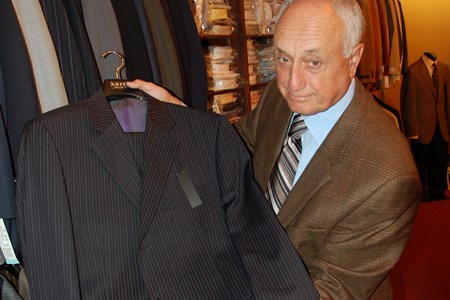When asked if it’s ever appropriate to wear shorts to work in the summer, Tony D’Angelo sits speechless for a moment.
"You’re not going to get my vote. I wouldn’t think so in an office. I don’t think so at all. If you went to a dentist, and he had shorts on, would that be acceptable to you?
D’Angelo, who owns Joe Lesar Men’s Wear Ltd. in downtown Sudbury along with business partner Fred Zimmer, said dressing appropriately for the work environment shows respect for employers, co-workers and clients.
But many workers, particularly those belonging to younger generations, simply don’t know how to dress appropriately.
"We grew up in an era when we dressed. Now it’s just not important to anybody, especially the 30-year-old guys."
D’Angelo said he even observed a young man wearing a plain white t-shirt and shorts at a funeral recently. "I said to him ‘Excuse me? You’ve got clothes. Go home and change.’
He said ‘I just got off the plane.’ I said, ‘I don’t care where you got off’."
Men working in an office environment should be wearing a dress shirt and dress pants, h
e said. Ties are a nice touch, but they have lost popularity in recent years, D’Angelo said.
While shorts should definitely never be worn in the vast majority of workplaces, D’Angelo doesn’t have a problem with men wearing short-sleeved sports or dress shirts on a hot day. "I’d rather see them in a nice short-sleeved sports shirt than a t-shirt," he said.
Casual Fridays, said D’Angelo, have gradually come to mean Jeans Fridays. While jeans shouldn’t necessarily be vetoed in the workplace, costlier, tailored jeans are more appropriate for business wear, he said.
Employees should look at how the managers of their company dress, and start dressing similarly, said Karen Brunger, director of the International Image Institute in Richmond Hill.
"Clothes can make a difference in your career. Absolutely. No question. They can either open the door for you or close it. It doesn’t mean that you can’t succeed without the right clothes, but it can certainly make it easier."
Among other services, Brunger’s business provides image consultations for clients focusing on appearance, behaviour and communication.
The services of image consultants cost between $100 to $300 an hour depending on the consultant’s experience and qualifications, she said. Business executives and politicians are frequent clients, Brunger said.
"Usually there’s an assessment first to find out what their needs are so we can set up the program. It’s tailored to each individual," she said.
"It could involve a colour and style analysis, a wardrobe audit, wardrobe planning, personal shopping, etiquette coaching and coaching through the art of conversation. Some might even coach in presentation skills and body language."
Before deciding on a new wardrobe for clients, Brunger carefully assesses the corporate culture of their workplace.
For those working in the banking or financial industry, she recommends dark, sober suits that inspire trust in clients. People working in more "creative" industries such as advertising, architecture or interior design can dress more casually, she said.
"They have colour, they have variations in style, they have more flexibility in what they wear. Even if they are wearing a suit, they have flexibility in the colour and styling, especially for women. It’s a different look."
Women have a harder time than men with dressing formally for high-powered business situations, she said.
"One woman who does a pretty good job is our governor general (Michaelle Jean). But even she has to modify the suit for her woman’s body," said Brunger.
"When she was sworn in as governor general, she wore a black skirted suit. The man gets to have his shirt buttoned all the way up. But a woman can’t do that because it doesn’t go with the lapel of the jacket. Her collar was a little bit open.
"Right away, her image is projected as being open. That means ‘I can be swayed, I can be talked into something.’ When a man has his shirt buttoned all the way up to the top and knotted with a tie, he’s not open. You listen to him, that’s it. Women have a really challenging time at that level."
On the other hand, when it comes to dressing more casually for work, women are in their glory, because they can wear every colour in the rainbow, she said.
"Men have more rigidly designed clothing. They don’t have pink jackets. Well they might, but it’s not appropriate even for business casual wear."
Brunger said there aren’t many image consultants outside of southern Ontario. The only one she knows of is Maria Smith in Thunder Bay.
To find an image consultant, go to the Association of Image Consultants International’s website.




